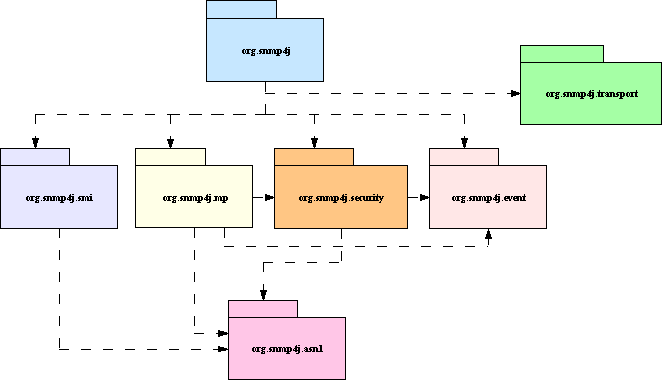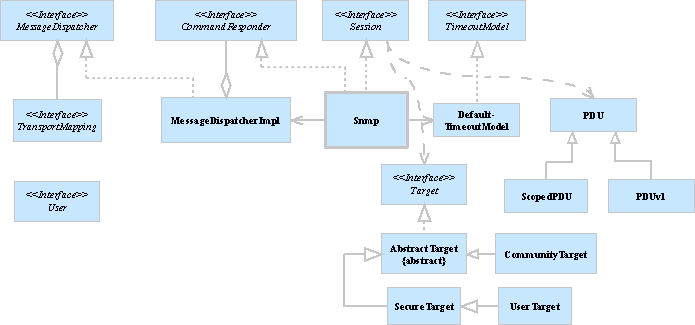Package org.snmp4j
The org.snmp4j classes are capable of creating, sending, and
receiving SNMPv1/v2c/v3 messages. A SNMP message is composed of its message
header and its PDU payload. This package contains three main groups of classes
and interfaces:
- Classes for SNMP message and target creation
- Classes for SNMP message sending (command generation)
- Classes for SNMP message dispatching (command responding)
The following UML package diagram illustrates the dependencies between the
packages of the core SNMP4J API. Users of the API normally only need to use the
org.snmp4j and the org.snmp4j.smi packages directly.

The following UML class diagram shows the most important classes of the org.snmp4j package and their relationships (relationships to other packages are not shown):.

SNMP Messages and Targets
To exchange a SNMP message with a remote system, that system has to be identified,
retransmission, and timeout policy information about the message exchange has
to be specified. A remote system is specified with SNMP4J by creating a
Target instance appropriate for the SNMP protocol to be used.
- For SNMPv1 and SNMPv2c the
CommunityTargethas to be used which provides community information in addition to the address, retransmission, and timeout policy information defined by theTargetinterface. -
For SNMPv3 the
UserTargethas to be used instead. It extends theSecureTargetabstract class and provides the following User Based Security Model (USM) user information: security name, security level, security model (i.e. USM), and authoritative engine ID.
A SNMP message consists of the message's payload, the SNMP Protocol Data Unit
(PDU) and a message header. Simplified said, in SNMP4J the message header
information is represented by Target instances and the PDU is
represented by one of the following classes:
-
PDUv1(SNMPv1) -
PDU(SNMPv2c) -
ScopedPDU(SNMPv3)
PDU
instance and a Target instance have to be created.
PDU Examples
- SNMPv1/v2c GETNEXT PDU
import org.snmp4j.PDU; import org.snmp4j.smi.*; ... PDU pdu = new PDU(); pdu.add(new VariableBinding(new OID("1.3.6.1.2.1.1.1"))); // sysDescr pdu.add(new VariableBinding(new OID("1.3.6.1.2.1.2.1"))); // ifNumber pdu.setType(PDU.GETNEXT); ... - SNMPv3 GETBULK PDU
import org.snmp4j.ScopedPDU; import org.snmp4j.smi.*; ... ScopedPDU pdu = new ScopedPDU(); pdu.add(new VariableBinding(new OID("1.3.6.1.2.1.2.1"))); // ifNumber pdu.add(new VariableBinding(new OID("1.3.6.1.2.1.2.2.1.10"))); // ifInOctets pdu.add(new VariableBinding(new OID("1.3.6.1.2.1.2.2.1.16"))); // ifOutOctets pdu.setType(PDU.GETBULK); pdu.setMaxRepetitions(50); // Get ifNumber only once pdu.setNonRepeaters(1); // set context non-default context (default context does not need to be set) pdu.setContextName(new OctetString("subSystemContextA")); // set non-default context engine ID (to use targets authoritative engine ID // use an empty (size == 0) octet string) pdu.setContextEngineID(OctetString.fromHexString("80:00:13:70:c0:a8:01:0d")); ... - SNMPv1 TRAP PDU
import org.snmp4j.PDUv1; ... PDUv1 pdu = new PDUv1(); pdu.setType(PDU.V1TRAP); pdu.setGenericTrap(PDUv1.COLDSTART); ... - SNMPv2c/SNMPv3 INFORM PDU
import org.snmp4j.ScopedPDU; ... ScopedPDU pdu = new ScopedPDU(); pdu.setType(PDU.INFORM); // sysUpTime long sysUpTime = (System.nanoTime() - startTime) / 10000000; // 10^-7 pdu.add(new VariableBinding(SnmpConstants.sysUpTime, new TimeTicks(sysUpTime))); pdu.add(new VariableBinding(SnmpConstants.snmpTrapOID, SnmpConstants.linkDown)); // payload pdu.add(new VariableBinding(new OID("1.3.6.1.2.1.2.2.1.1"+downIndex), new Integer32(downIndex))); ...
Target Examples
- Community Target
CommunityTarget target = new CommunityTarget(); target.setCommunity(new OctetString("public")); target.setAddress(targetAddress); target.setVersion(SnmpConstants.version1); - User Target
UserTarget target = new UserTarget(); target.setAddress(targetAddress); target.setRetries(1); // set timeout to 500 milliseconds: 2*500ms = 1s total timeout target.setTimeout(500); target.setVersion(SnmpConstants.version3); target.setSecurityLevel(SecurityLevel.AUTH_PRIV); target.setSecurityName(new OctetString("MD5DES"));
Sending SNMP messages
SNMP message are sent with SNMP4J by using a instance of the SNMP
Session interface. The default implementation of this interface
is the Snmp class.
To setup a Snmp instance it is sufficient to call its
constructor with a TransportMapping instance. The transport
mapping is used by the SNMP session to send
(and receive) SNMP message to a remote systems by using a transport protocol,
for example the User Datagram Protocol (UDP).
A SNMP4J Snmp instance supports SNMP v1, v2c, and v3 by default.
By sub-classing Snmp other combinations of those SNMP protocol
versions can be supported.
With SNMP4J, SNMP messages can be sent synchronously (blocking) and
asynchronously (non-blocking). The Snmp class does not use
an internal thread to process responses on asynchronous and synchronous
requests. Nevertheless it uses the receiver threads of the transport mappings
to process responses.
Asynchronous responses are returned by calling a callback method
on an object instance that implements the ResponseListener
interface. The callback is carried out on behalf of the transport mapping
thread that received the response packet from the wire.
Thus, if the called method blocks, the delivery of synchronous and
asynchronous messages received on the listen port of that transport mapping
will be also blocked. Other transport mapping will not be affected.
Blocking can be avoided by either using synchronous messages only or by
decoupling the processing within the callback method.
Example for Sending a Synchronous Message
import org.snmp4j.*;
...
Snmp snmp = new Snmp(new DefaultUdpTransportMapping());
snmp.listen();
...
ResponseEvent response = snmp.send(requestPDU, target);
if (response.getResponse() == null) {
// request timed out
...
}
else {
System.out.println("Received response from: "+
response.getPeerAddress());
// dump response PDU
System.out.println(response.getResponse().toString());
}
Example for Sending an Asynchronous Message
import org.snmp4j.*;
import org.snmp4j.event.*;
...
Snmp snmp = new Snmp(new DefaultUdpTransportMapping());
snmp.listen();
...
ResponseListener listener = new ResponseListener() {
public void onResponse(ResponseEvent event) {
// Always cancel async request when response has been received
// otherwise a memory leak is created! Not canceling a request
// immediately can be useful when sending a request to a broadcast
// address.
((Snmp)event.getSource()).cancel(event.getRequest(), this);
PDU response = event.getResponse();
PDU request = event.getRequest();
if (response == null) {
System.out.println("Request "+request+" timed out");
}
else {
System.out.println("Received response "+response+" on request "+
request);
}
}
};
snmp.sendPDU(request, target, null, listener);
...
Receiving SNMP messages
SNMP4J receives SNMP messages through the listen port of transport mappings.
In order to be able to receive responses or requests, that port needs to be
set into listen mode. This has to be done by calling the listen()
method of the TransportMapping instance to start the transport
mappings internal listen thread. The internal thread is stopped and the listen
port is closed by calling the close() method on the
TransportMapping instance or the associated Snmp
instance.
The transport mapping just receives the SNMP mesage as a stream of bytes and
forwards the message to associated MessageDispatcher instances.
By default, SNMP4J uses one instance of the MessageDispatcherImpl
class for decoding and dispatching incoming messages. That instance is created
and used internally by the Snmp class.
The Snmp class processes responses to outstanding requests and
forwards PDUs of other SNMP messages to registered CommandResponder
listener instances. To receive SNMP messages it is thus sufficient to
-
Create a
TransportMappingand initialize its listen port by callingTransportMapping.listen(). -
Create a
Snmpinstance with the aboveTransportMapping. -
Instantiate a class that implements the
CommandResponderinterface and register it with theSnmpinstance by callingSnmp.addCommandResponder(CommandResponder).
When a unhandled SNMP message (thus a SNMP message where no corresponding
outstanding request exists) is received, then the
processPdu(CommandResponderEvent) method of the
CommandResponder will be called with the decoded PDU and
additional information about the received SNMP message provided by the
message processing model that has decoded the SNMP message.
Example for Receiving SNMP Messages
import org.snmp4j.*;
import org.snmp4j.smi.*;
import org.snmp4j.mp.SnmpConstants;
...
TransportMapping transport =
new DefaultUdpTransportMapping(new UdpAddress("0.0.0.0/161"));
Snmp snmp = new Snmp(transport);
if (version == SnmpConstants.version3) {
byte[] localEngineID =
((MPv3)snmp.getMessageProcessingModel(MessageProcessingModel.MPv3)).createLocalEngineID();
USM usm = new USM(SecurityProtocols.getInstance(),
new OctetString(localEngineID), 0);
SecurityModels.getInstance().addSecurityModel(usm);
snmp.setLocalEngine(localEngineID, 0, 0);
// Add the configured user to the USM
...
}
snmp.addCommandResponder(this);
snmp.listen();
...
public synchronized void processPdu(CommandResponderEvent e) {
PDU command = e.getPdu();
if (command != null) {
...
}
}
-
ClassDescriptionA
AbstractTargetclass is an abstract representation of a remote SNMP entity.TheCertifiedIdentityinterface describes an identity that is associated with a client certificate fingerprint and a server certificate fingerprint.TheCertifiedTargetclass implements aSecureTargetfor usage withSecurityModels that support secured connections using client and server certificates.CommandResponderprocess incoming request, report and notification PDUs.TheCommandResponderEventis fired by theMessageDispatcherto listeners that potentially can process the included request, report, or trap/notification.ACommunityTargetrepresents SNMP target properties for community based message processing models (SNMPv1 and SNMPv2c).TheDefaultTimeoutModelimplements a timeout model that uses constant timeouts between retries.TheMessageDispatcherinterface defines common services of instances that process incoming SNMP messages and dispatch them to interestedCommandResponderinstances.TheMessageDispatcherImpldecodes and dispatches incoming messages usingMessageProcessingModelinstances and encodes and sends outgoing messages using an appropriateTransportMappinginstances.TheMessageExceptionrepresents information about an exception occurred during message processing.TheMutablePDUis a container for aPDUinstance.ThePDUclass represents a SNMP protocol data unit.ThePDUv1represents SNMPv1 PDUs.TheScopedPDUclass represents a SNMPv3 scoped PDU.TheSecureTargetis an security model independent abstract class for all targets supporting secure SNMP communication.Sessiondefines a common interface for all classes that implement SNMP protocol operations based on SNMP4J.TheSnmpclass is the core of SNMP4J.Interface for handling reports.TheSNMP4JSettingsclass implements a central configuration class of the SNMP4J framework.Specifies how the security level of retry requests after a REPORT PDU is set.ATargetinterface defines an abstract representation of a remote SNMP entity.TheTimeoutModelis the common interface for all models of timing out a SNMP request.TransportMapping<A extends Address>TheTransportMappingdefines the common interface for SNMP transport mappings.TheTransportStateReferenceclass holds information defined by RFC 5343 for the tmStateReference ASI elements.Common interface that has to be implemented by all user based security models user classes.User based target for SNMPv3 or later.